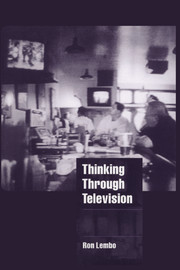Book contents
- Frontmatter
- Contents
- Acknowledgments
- Introduction: Situating my experience with television
- PART I Conceptions of television use
- PART II Reconceptualizing television use
- PART III Documenting the viewing culture
- 6 Methodology and the turn to television
- 7 The practice of viewing
- 8 A typology of television use
- Conclusion: The politics of television reconsidered
- References
- Index
6 - Methodology and the turn to television
Published online by Cambridge University Press: 22 September 2009
- Frontmatter
- Contents
- Acknowledgments
- Introduction: Situating my experience with television
- PART I Conceptions of television use
- PART II Reconceptualizing television use
- PART III Documenting the viewing culture
- 6 Methodology and the turn to television
- 7 The practice of viewing
- 8 A typology of television use
- Conclusion: The politics of television reconsidered
- References
- Index
Summary
Understanding the sociality of television use requires that the analyst provide some systematic way of exploring what typically goes on, socially speaking, when people become involved in the various activities that constitute their daily, weekly, and monthly routines of relaxation and enjoyment in the home. My strategy of empirical research into television use, beginning in the late 1980s, was to reconstruct people's social experience with television across the different, yet interrelated, phases that constitute what I call the viewing culture, with the purpose of doing research that stayed as close as possible to the lives of the people involved. The phases of television use that I began with are (1) the turn to television, (2) interaction with television imagery, and (3) leaving television and fitting it back into daily life. Now, a decade later, this still seems an important way of understanding the significance that television use holds for people. By looking at television viewing in the context of everyday life, one is led to re-examine many of the claims that cultural studies' analysts often make regarding the workings of the medium's power. This chapter attempts both to explain why one needs to look at television's influence in this context and to actually examine some of these influences. After some important preliminary discussion of methodological concerns, I focus on empirical research that looks only at the initial phase of television use, the turn to television, and discuss in some detail the significant patterns emerging from my research.
- Type
- Chapter
- Information
- Thinking through Television , pp. 117 - 166Publisher: Cambridge University PressPrint publication year: 2000



